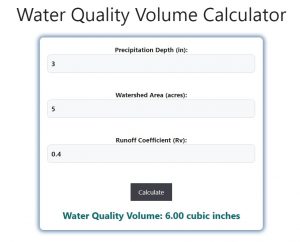About Water Quality Volume Calculator (Formula)
The Water Quality Volume Calculator is an essential tool for engineers, environmental scientists, and anyone involved in watershed management. It helps determine the volume of water that can potentially affect water quality in a given area based on precipitation. By calculating the water quality volume, users can design better stormwater management systems and implement effective strategies to reduce pollution and improve water quality. This article will walk you through the formula, usage, and practical examples of using the Water Quality Volume Calculator.
Formula
The formula for calculating water quality volume is:
Water Quality Volume = Precipitation Depth * Watershed Area * Runoff Coefficient
Where:
- Water Quality Volume is the total volume of water that can impact water quality.
- Precipitation Depth refers to the amount of rain or snowfall in inches.
- Watershed Area is the total area of the watershed measured in acres.
- Runoff Coefficient is a factor that represents the fraction of precipitation that becomes runoff, varying based on land use and surface type.
How to Use
Using the Water Quality Volume Calculator involves the following steps:
- Measure Precipitation Depth: Obtain the depth of precipitation for the period you want to assess, typically measured in inches.
- Determine Watershed Area: Calculate the area of the watershed in acres. This involves measuring the land area that drains into a particular water body.
- Select Runoff Coefficient: Choose the appropriate runoff coefficient based on land use (e.g., urban, agricultural, forested). This information can often be found in local environmental guidelines.
- Input Values: Enter the precipitation depth, watershed area, and runoff coefficient into the calculator.
- Calculate Water Quality Volume: Click the calculate button to find the water quality volume, which will help you assess potential water quality impacts.
Example
For instance, let’s say you have the following data:
- Precipitation Depth: 3 inches
- Watershed Area: 5 acres
- Runoff Coefficient: 0.4 (representing a mixed-use area)
Using the formula:
Water Quality Volume = Precipitation Depth * Watershed Area * Runoff Coefficient
= 3 in * 5 acres * 0.4
= 6 acre-inches
This means that the total volume of water affecting water quality in this scenario is 6 acre-inches.

FAQs
- What is water quality volume?
Water quality volume refers to the amount of water that can impact the quality of a water body, often resulting from precipitation. - Why is calculating water quality volume important?
It helps in designing effective stormwater management systems and assessing the potential impact of runoff on water quality. - What is a runoff coefficient?
The runoff coefficient is a factor that quantifies the portion of precipitation that becomes surface runoff, depending on the land surface characteristics. - How do I find the runoff coefficient for my area?
Runoff coefficients can usually be obtained from local environmental agencies or engineering guidelines. - What units are used for precipitation depth?
Precipitation depth is typically measured in inches. - How do I calculate watershed area?
Watershed area can be calculated using maps, GPS technology, or geographic information systems (GIS). - What types of land use affect runoff coefficients?
Urban, agricultural, and forested areas have different runoff coefficients due to variations in surface material and vegetation cover. - Can this calculator be used for different types of watersheds?
Yes, the calculator can be applied to any watershed, but the runoff coefficients must be adjusted based on the specific land use. - What happens to water quality volume during heavy rainfall?
Increased rainfall can lead to higher water quality volumes, which may increase the risk of pollutants entering water bodies. - How often should I calculate water quality volume?
It’s beneficial to recalculate following significant rainfall events or changes in land use. - Are there environmental regulations regarding water quality volume?
Yes, many regions have regulations aimed at maintaining water quality, which may include managing runoff volumes. - What tools can help in measuring precipitation depth?
Rain gauges or local weather stations can provide accurate measurements of precipitation depth. - How does urbanization affect water quality volume?
Urbanization typically increases runoff due to impervious surfaces, leading to higher water quality volumes and potential pollutant loads. - What is the impact of increased water quality volume?
Higher volumes can lead to more runoff entering water bodies, which may carry pollutants and degrade water quality. - Can this calculator be used for long-term studies?
Yes, it can be used for both short-term assessments and long-term studies to monitor changes in water quality over time. - What actions can be taken if water quality volume is too high?
Implementing green infrastructure, such as rain gardens or permeable pavements, can help manage excessive runoff. - What other factors influence water quality?
In addition to water quality volume, factors such as temperature, nutrient levels, and human activities can impact overall water quality. - How does climate change affect precipitation and runoff?
Climate change can lead to more extreme weather patterns, increasing precipitation intensity and altering runoff patterns. - What is the relationship between water quality volume and flooding?
High water quality volumes can contribute to flooding if the runoff exceeds the capacity of drainage systems. - Are there software tools available for water quality volume calculations?
Yes, various environmental modeling software programs can assist with more complex calculations and simulations related to water quality.
Conclusion
The Water Quality Volume Calculator is a vital tool for anyone involved in watershed management and environmental protection. By accurately calculating the volume of water that may affect water quality, users can better plan and implement strategies to mitigate runoff impacts and maintain healthy water systems. Understanding the principles behind the calculator and following best practices can lead to improved water quality and a healthier environment.
